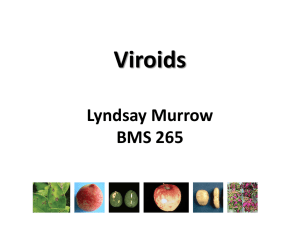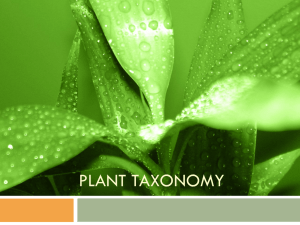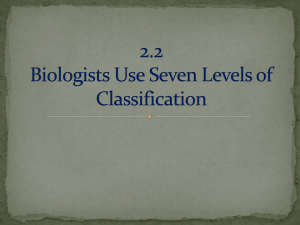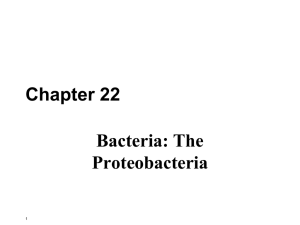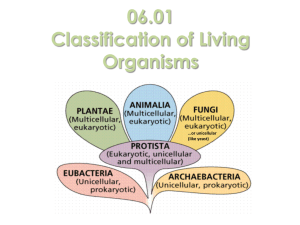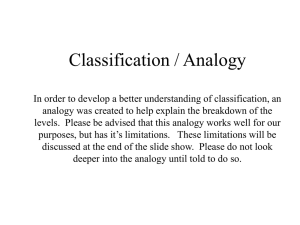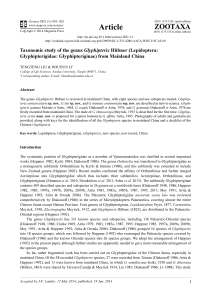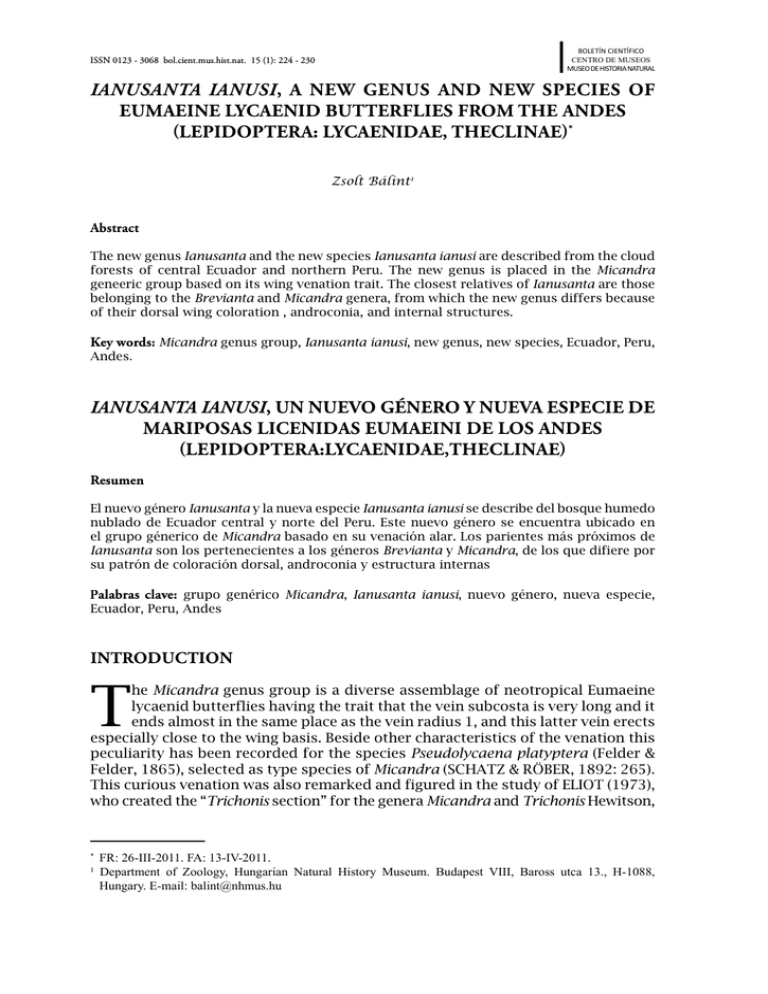
BOLETÍN CIENTÍFICO
CENTRO DE MUSEOS
MUSEO DE HISTORIA NATURAL
ISSN 0123 - 3068 bol.cient.mus.hist.nat. 15 (1): 224 - 230
IANUSANTA IANUSi, a new genus and new species of
eumaeine lycaenid butterflies from the Andes
(Lepidoptera: Lycaenidae, THECLINAE)*
Zsolt Bálint1
Abstract
The new genus Ianusanta and the new species Ianusanta ianusi are described from the cloud
forests of central Ecuador and northern Peru. The new genus is placed in the Micandra
geneeric group based on its wing venation trait. The closest relatives of Ianusanta are those
belonging to the Brevianta and Micandra genera, from which the new genus differs because
of their dorsal wing coloration , androconia, and internal structures.
Key words: Micandra genus group, Ianusanta ianusi, new genus, new species, Ecuador, Peru,
Andes.
IANUSANTA IANUSI, UN NUEVO GÉNERO Y NUEVA ESPECIE DE
MARIPOSAS LICENIDAS EUMAEINI DE LOS ANDES
(LEPIDOPTERA:LYCAENIDAE,THECLINAE)
Resumen
El nuevo género Ianusanta y la nueva especie Ianusanta ianusi se describe del bosque humedo
nublado de Ecuador central y norte del Peru. Este nuevo género se encuentra ubicado en
el grupo génerico de Micandra basado en su venación alar. Los parientes más próximos de
Ianusanta son los pertenecientes a los géneros Brevianta y Micandra, de los que difiere por
su patrón de coloración dorsal, androconia y estructura internas
Palabras clave: grupo genérico Micandra, Ianusanta ianusi, nuevo género, nueva especie,
Ecuador, Peru, Andes
INTRODUCTION
T
he Micandra genus group is a diverse assemblage of neotropical Eumaeine
lycaenid butterflies having the trait that the vein subcosta is very long and it
ends almost in the same place as the vein radius 1, and this latter vein erects
especially close to the wing basis. Beside other characteristics of the venation this
peculiarity has been recorded for the species Pseudolycaena platyptera (Felder &
Felder, 1865), selected as type species of Micandra (Schatz & Röber, 1892: 265).
This curious venation was also remarked and figured in the study of Eliot (1973),
who created the “Trichonis section” for the genera Micandra and Trichonis Hewitson,
*
1
FR: 26-III-2011. FA: 13-IV-2011.
Department of Zoology, Hungarian Natural History Museum. Budapest VIII, Baross utca 13., H-1088,
Hungary. E-mail: balint@nhmus.hu
Ianusanta ianusi, a new genus and new species of eumaeine lycaenid butterflies
225
1865 (type species: Papilio theanus Cramer, 1777). Partly on the basis of results
published by CLENCH (1971) the tight relationship of Micandra and Trichonis was
falsified by ROBBINS (1987) and later the “Micandra section” has been proposed
for twelve genera (ROBBINS, 2004).
The Micandra genus group is relatively diverse having 149 species according to
ROBBINS (2004), but the diversity is obviously higher (cf. BÁLINT & WOJTUSIAK,
2006; PRIETO et al., 2008; BÁLINT et al., 2010; SALAZAR, 2010). Most of the species
dwell cloud forests in mountainous regions from México to Bolivia. Although
sometimes it is easy to collect the imagines using bait traps, the Micandra genus
group diversity has been revealed only recently in the Andes when new trails or
tracks became available to reach unexplored areas. On the other hand there are
genera or species which descend to lowlands or inhabit high altitude paramos
and puna, therefore they are in need for different collecting methods. Probably
these are the reasons why certain genera remained under represented or very
rare in scientific collections up to the recent times. Hence many genera became
monographed only just in the last decades (JOHNSON, 1992; PRIETO, 2008; PRIETO
et al., 2008; ROBBINS & BUSBY, 2008).
Here in this paper I describe a magnificent cloud forest species representing
the Micandra genus group, which in male genital configurations, seems to be
superficially close to Micandra. The species can be distinguished immediately from
all the known Micandra species on the basis of male dorsal structural colouration
and androconia, plus ventral wing pattern. Another genus is Brevianta, which
seems to be even more closely related, because it has some superficially similar
species; but representatives of Brevianta are markedly different in their genitalia
and also in male androconia.
IANUSANTA Bálint, gen. n.
Type species: Ianusanta ianusi sp. n.
Diagnosis: Male foreleg used for walking with fused foretarsus (Lycaenidae), ten
forewing veins, in lateral view “greyhound shaped” male genitalia without juxta
(Eumaeini), veins subcosta and radius 1 are approximating each other at their
termini (Micandra genus group), a forewing dorsal scent pad trapezoid in shape
present in discalis apex without any additional androconial cluster (Ianusanta).
Male wings dorsally blue with wide black margin, hindwing vein cubitus 2 terminus
with short tail, tornus lobed. Wings ventrally brown with white submedian and
postmedian lines running parallel from costa to anal margin in forewing, and with
thin submedian and postmedian V-shaped pattern in hindwing; male genitalia
flat in lateral aspect, valval terminal process with strong setae, adeagus with two
cornutii, terminal dorsad-caudad one larger with bristles.
Diversity: Monotypic.
Etymology: The genus group name “Ianusanta” is composed from the Latin
transliteration variant of the Polish name Janusz with the suffix “anta” making
the name in rhyme with Brevianta and Micandra, genera in supposedly close
226
Bálint
relationship. The species group name is similarly derived from Janusz; being
Latinized and placed in genitive. The specific epithet is dedicated to Professor
Janusz Wojtusiak (Jagiellonian University, Krakow, Poland) specialist of Neotropical
erateine and tortricid moths, long time friend and collaborator of mine working in
Neotropical lycaenid butterflies.
Notes: The genus Ianusanta intermediates the genera Brevianta and Micandra both
in facies and anatomical details. The most conspicuous trait is the trapezioid shape
of the forewing discal scent pad, which does not occur in any of the mentioned
genera, but well recorded in the case of “Penaincisalia” (PRIETO, 2008). The genus
Penaincisalia Johnson, 1990 (type species: Thecla culminicola Staudinger, 1894)
belongs also to the relatives of Micandra, but in those species where trapezoid
scent pad occurs there is always an additional scent patch at the erection of vein
media 3 (BÁLINT & WOJTUSIAK, 2006). The genital capsula in lateral view is flat in
Ianusanta, like in Egides Johnson, Kruse & Kroenlein, 1997 (type species: Thecla
aegides Felder & Felder, 1865) but this latter genus posseses brush organ. Egides
is considered to be a junior synonym of Micandra by ROBBINS (2004).
I do not speculate about the “phylogenetic” position of the genus, only I would
like to point out that the type species has most probable a remarkable life history
or it has a peculiar position in a community of lycaenids testified by the unique
combination of the characteristic structural colour and androconia.
Ianusanta ianusi Bálint, sp. n. (Figs. 1-4)
Type: HOLOTYPE male (ex collection König II, will be deposited in Naturhistorisches
Museum, Wien), forewing length 20 mm, in moderate condition, set dorsally, left
antenna and abdomen missing (abdomen dissected, and placed under the specimen
on its pin in plastic microvial containing glycerin), labelled as (1) “Jorge Chavez [//],
1600 m, N. Peru [//], 2003. XII. [//] Coll. F. König (white paper, printed; characters
in italics written with black ink by hand); (2) Gen. n. [//] sp. n. [//] gen. prep. No.
1096 [//] det. Zs. Bálint” (white label with black frame, printed; characters in italics
written with blue ink by hand); the label “Ianusanta ianusi, February 2011, det. Zs.
Bálint, Budapest” printed in red paper will be provided to the specimen.
Diagnosis: The species intermediates Brevianta and Micandra. Males can be
bol.cient.mus.hist.nat. 15 (1): 224 - 230
immediately recognized on the basis of blue dorsal colouration (somewhat deeper
or more vivid blue both in Brevianta and Micandra), the dorsal forewing scent pad
in the discalis apex trapezoidal in shape and formed by minute brown androconia
(no similar scent pad in Brevianta nor in Micandra), and the straight median and
postmedian white tranverse lines running parallel (these are approximating and/
or bent in Brevianta and Micandra).
Description – Male: Wings (Figs. 1-3): forewing length 20 mm measured from the
erection of main veins to terminus of vein radius 3. Shape (Figs. 1-2): forewing costal
margin slightly convex, distal and innner margin straight; hindwing costa, apex
rounded, distal margin straight, vein cubitus 2 tailed, tornus with large lobe formed
by elongated veins cubitus 2 and vannal 2; fringes on both wings formed by long
white scales. Dorsal surface (Fig. 1): both wings with bright greenish blue colour
strongly angle dependent; forewing discalis apex with scent pad trapezioid in shape
Ianusanta ianusi, a new genus and new species of eumaeine lycaenid butterflies
227
and flat grey; hindwing anal area below vein cubitus 1 covered by long hairs. Ventral
surface (Fig. 2): forewing ground colour reddish brown with straight transverse
median and postmedian white line running parallel from costa to vein cubitus 2,
intervenial area between veins cubitus 2 and vannal 2 grey with obsolete and oblique
white median mark running basad from median line end to costa, submargin with
white scale suffusion, margin darker brown with white antemarginal line very
thin; hindwing similar in colouration to forewing but with thinner submedian and
postmedian white V shaped line running from costa to anal margin with sharp angle
break at vein cubitus 2, tornal lobe anally black otherwise reddish brown as ground
colour. Androconia (Fig. 3): comprised by scent scales much smaller than ordinary
colour generating scales, densely arranged and standing almost perpendicularly to
wing membrane, long and narrow in shape with rounded apex, reddish brown in
colour under larger magnification. Body: head with black scape and white pedicel,
antennal club light brown, vertex with a tuft of long reddish brown and white scales,
sclerite with brown and projecting scales, paraocular area white, labial palp also
white; thorax and abdomen dorsally blue, ventrally reddish brown, legs inner side
white. Genitalia (Fig. 4): aedeagus almost two times longer than genital capsule
in lateral view, subzonal part with 1/3 entire aedeagus length, terminus with two
cornutii: with larger and serrated dorsad-caudad cornutus and smaller and plain
ventrad-cephalad cornutus; uncus strong with dorsad-cephalad scerotized rim;
gnathos with thin terminal apiculus; tegumen with sclerotized lower edge and
membranous process supporting aedeagus; vinculum sclerotized and narrow;
saccus as long as its widest caudual edge; valva with subzonal aedeagus length,
dorsal edge projecting dorsad with pointed sclerotized process approximately at
middle and folding cephalad forming a pocket or deep rim, terminus with thin
process projecting caudad and possesing strong setae.
Distribution: Geographical: known from central Ecuador (Macas, Morona-Santiago)
and northern Peru (Jorge Chávez, Amazonas); spatial: collected at elevations 1440
m (Ecuador) and 1600 m (Peru); temporal: collected in January (Ecuador) and
December (Peru).
Notes: The specimen selected here as Ianusanta ianusi holotype was sent to me
in 2004 by Fritz König (Saalfelden, Austria) from his “Sammlung König II”. I was
also informed via having the images of the Sammlung König II Lycaenidae drawers
that there were further two male I. ianusi specimens. I was unable to collect more
information about these specimens as the correspondance between me and Herr
König became disrupted by his illness.
The holotype is at present in the Hungarian Natural History Museum, but will be
transferred to the Naturhistorisches Museum with the return of the Lycaenidae
part of König Sammlung I, which is in loan in Budapest due to the colleagic support
and generosity of the curator Dr Martin Lödl.
The species was collected recently and photographed also alive by the French
lepidoptersist Pierre Boyer in central Ecuador.
bol.cient.mus.hist.nat. 15 (1): 224 - 230
228
Bálint
Fig. 1.
Holotype of Ianusanta ianusi Bálint, sp. n. in dorsal view.
Fig. 2.
Holotype of Ianusanta ianusi Bálint, sp. n. in ventral view.
Ianusanta ianusi, a new genus and new species of eumaeine lycaenid butterflies
229
Fig. 3.
Dorsal forewing scent pad of Ianusanta ianusi Bálint, sp. n. in the discalis apex comprised
by androconia, surrounded by larger colour producing ordinary scales.
Fig. 4.
Male genitalia of Ianusanta ianusi Bálint, sp. n. holotype in dorsal view.
ACKNOWLEDGEMENTS
I thank to Mr. Julián A. Salazar and to an anonymous reviewer for their comments
on the manuscript. I express also my sincere thank to Mr. Pierre Boyer, who shared
his knowledge about this magnificent species.
230
Bálint
BIBLIOGRAPHY
bol.cient.mus.hist.nat. 15 (1): 224 - 230
Bálint, Zs. & J. Wojtusiak, J., 2006.- Contributions to the knowledge of Neotropical Lycaenidae: Notes
on Thecloxurina with the description of three new species (Lepidoptera: Theclinae: Eumaeini). Genus,
Wroclaw, 17: 585-600.
Bálint, Zs.; Kertész, K. & Wojtusiak, J., 2010.- Notes on the high Andean cloud forest butterfly genus
Jagiello and its relatives with description of a new species from Peru (Lepidoptera: Lycaenidae). Annales
historico-naturales Musei nationalis hungarici, 102: 119-142.
CLENCH, H.K., 1971.- Two new hairstreaks from Mexico (Lepidoptera: Lycaenidae). Bulletin of the Allyn
Museum, 3: 1-6.
ELIOT, J.N., 1973.- The higher classification of the Lycaenidae (Lepidoptera): a tentative arrangement.
Bulletin of the British Museum of Natural History (Entomology), 28: 373-506.
JOHNSON, K. 1992.- Genera and species of the Neotropical „elfin”-like hairstreak butterflies (Lepidoptera,
Lycaenidae, Theclinae). Reports of the Museum of natural History, University of Wisconsin (Stevens
Point), 22: 1-135 (part I), 2136-279 (part II).
PRIETO, C., 2008.- Taxonomía, Biogeografía y Relaciones Filogeneticas del Género Alto-Adino Penaincisalia
Johnson (Lepidoptera: Lycaenidae: Eumaeini): Tesis Doctoral, Universidad de Alicante, Alicante. 268p.
Prieto, C.; Bálint, Zs.; Boyer, P. & Micó, E., 2008.- A review of the “browni group” of Penaincisalia with
notes on their distribution and variability (Lepidoptera: Lycaenidae: Eumaeini). Zootaxa, 1941: 1-24.
ROBBINS, R.K., 1987.- Evolution and identification of the New World hairstreak butterflies (Lycaenidae:
Eumaeini): Eliot’s Trichonis section and Trichonis Hewitson. Journal of the Lepidopterists’ Society, 40:
138-157, 8 figs.
________., 2004.- Lycaenidae. Theclinae. Tribe: Eumaeini (in) G. LAMAS (ed.), Checklist: Part 4A. Hesperioidea
– Papilionoidea: 118-137 (in) J.B. HEPPNER (ed.) Atlas of Neotropical Lepidoptera, Volume 5A. Gainesville:
Scientific Publishers. 439p.
ROBBINS, R.K. & BUSBY, R.C., 2008.- Phylogeny, taxonomy, and sympatry of Timaeta (Lycaenidae: Theclinae:
Eumaeini): an Andean montane forest endemic. Tijdschrift voor Entomologie, 151: 205-233.
SALAZAR, J.A., 2010.- Noticias sobre seis raras especies de licénidos Colombianos y descripción de una
nueva especie de Brevianta Johnson, Kruse & Kroenlein, 1997, para la Cordillera Occidental (Lepidóptera:
Lycvaenidae: Eumaeini). Bol. Cient. Mus. Hist. Nat. U de Caldas, 14: 189-202.
Schatz, E. & Röber, J., 1892.- Die Familien und Gattungen der Tagfalter systematisch und analytisch
Bearbeitet. Fürth (Bayern): Verlag von G. Löwensohn. ii + 284p., 50 pls., 78 figs.

